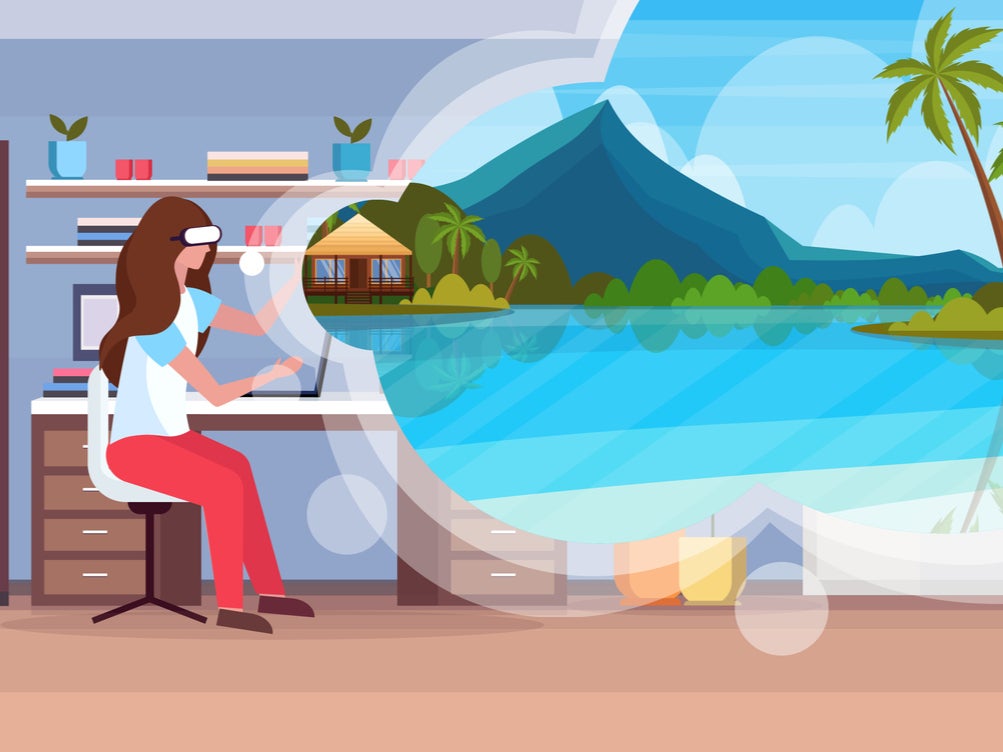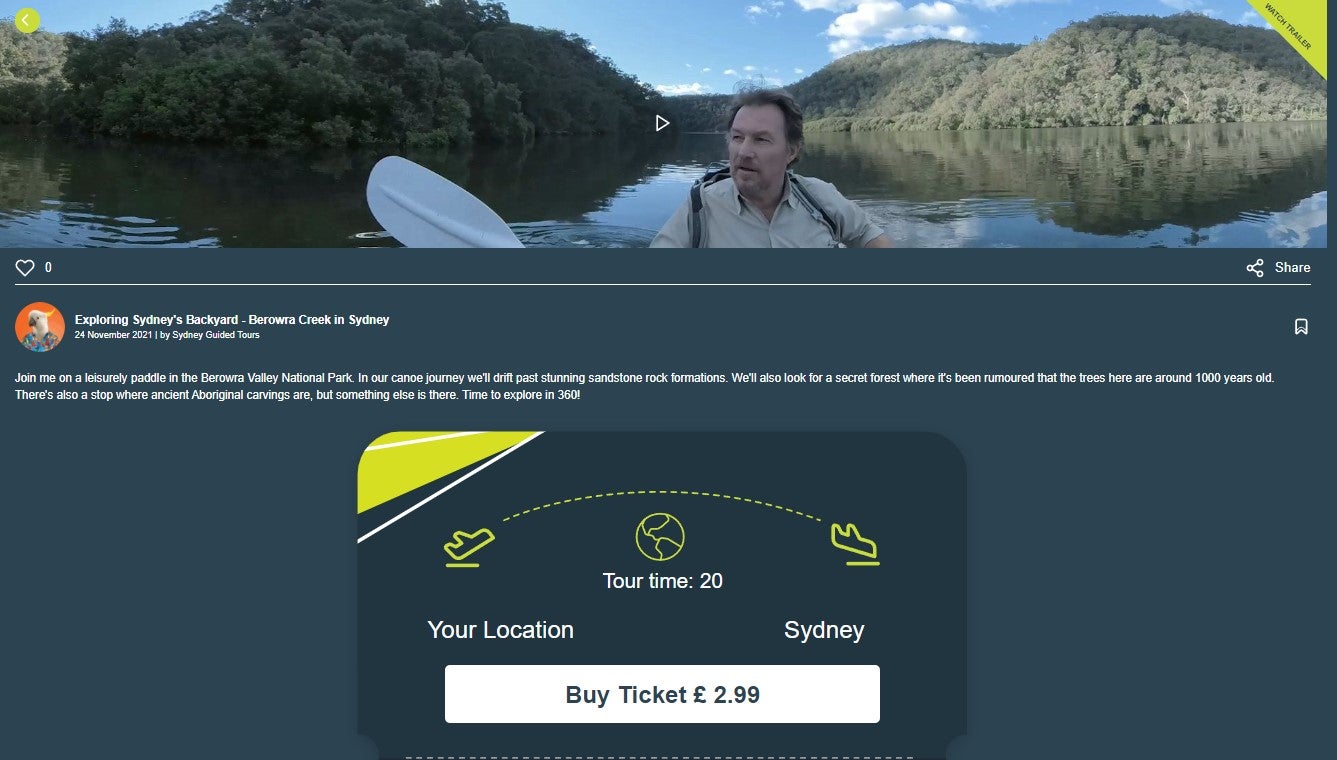How virtual reality is changing the way we book holidays
Whether it’s a sneak preview of a big-spend resort or an armchair-travel glimpse into the wilds of Japan or Lapland, we’re increasingly able to access a destination from the comfort of our homes. Lucy Thackray looks at the ways VR is changing how we book holidays


Your support helps us to tell the story
This election is still a dead heat, according to most polls. In a fight with such wafer-thin margins, we need reporters on the ground talking to the people Trump and Harris are courting. Your support allows us to keep sending journalists to the story.
The Independent is trusted by 27 million Americans from across the entire political spectrum every month. Unlike many other quality news outlets, we choose not to lock you out of our reporting and analysis with paywalls. But quality journalism must still be paid for.
Help us keep bring these critical stories to light. Your support makes all the difference.
In The Independent’s new travel trends column, Trendwatch, we dig into the types of trip, modes of transport and top buzzwords to watch out for.
How much research do you do around your destination and hotel before booking a trip? In the run-up to a recent holiday to Mauritius, I fear I lapsed into stalker territory – trawling the internet for any photo a passer-by may have taken of my prospective chunk of beach, hotel grounds and surrounding coastal area. I clicked compulsively through Tripadvisor’s “traveller” images – the real ones, with room service trays and dirty towels left out – through oyster.com’s “mystery shopper” images; through row upon row of sparkling #filtered Instagram images posted just that day.
It made me wonder if – having not travelled far, or freely, for some time – we are more obsessed than ever with what our holiday is going to look like.
Enter our latest travel trend, which promises to let you look left, right, up and down in your chosen holiday destination before even pressing “book”: virtual reality previews.
These got a fair bit of attention during 2020. As many struggled to travel, entrepreneurial tour guides and destinations set about trying to conduct “virtual tours” – often video show-arounds of everything from cities to iconic museums. No one was suggesting that we’d rather sit through a three-minute video of the pyramids than see the real thing; more that, in times of inaccessibility, technology can provide a marvellous shortcut.
Now, “going there without going there” is a rising trend, with whole content companies springing up around virtual reality. One such is Gecko Digital, which captures gyroscopic 360-degree imagery of a destination or resort, for use by tourist boards or in hotel marketing. Its founder, James South, compares the shift to VR to something as seismic as the move from black-and-white TV to colour, or journalists’ migration from static image to video.
Virtual reality puts you in the driving seat. It’s the exact window into what you’re booking
“We want to change the way people see the world forever,” he says, only sounding a tiny bit Bond villain. Currently specialising in capturing the Indian Ocean and southeast Asia, Gecko Digital is aiming to be the biggest global provider of this type of content. The 360-degree digital experience is “becoming the new medium, alongside photography and videography, to enable people to view destinations and hotels”, he says.
And you don’t need a whizzy VR headset, such as an Oculus (from £299), to view it: “For most people we know, those will still be niche,” says South. Instead, those booking a resort which has been captured in 360 will be able to tour and scroll around it using their fingers (on a smartphone) or mouse (on a desktop), looking around them as they go. It’s a bit like those virtual house tours where you click through into the next room, then the next – though more comprehensive, and with much better quality images.
He sees this type of VR as a more honest, more accurate preview for travellers, before they book. “Most destination photography shows a really wide-angle view, highly edited,” he explains. “Video is a narrative that that videographer wants to tell you – a story with models and make-up.
“Virtual reality puts you in the driving seat. It’s the exact window into what you’re booking – that is the view of the hotel. It’s the most honest, most transparent, best view of the hotel.”
This is a way of viewing our holidays which will initially hit the high-end, luxury end of the travel market. South describes a space-conscious punter being able to check just how close their water villa will be to their neighbour’s at a five-star Maldives resort. In May he’ll launch Igoroom, a “virtual travel agency” where luxe travel fans can explore the world’s exclusive, upmarket hotels from every angle, using 360.
It won’t be the first to offer a VR look around to a luxury audience. British Airways trialled VR headsets in selected first-class cabins back in 2019, with entertainment on board in 2D, 3D or 360-degree formats; while Barrhead Travel has used theme-park VR simulations to let families preview rides before booking trips to Orlando.
A slightly more inclusive use of the same technology is Virtually Visiting, a company which captures far-flung tours with 360-degree video technology, and uploads them for travel fans the world over to try out. It’s a thoughtful model, which pays for its own production costs when capturing the experience, gives the tour guide (often a small, independent company) a cut of the profits, and enables people who struggle to travel – be that due to prohibitive costs or mobility issues – to see more of the world.
On the website’s video tours – which might be a rickshaw guide of an Indian city, or an ice kayaking adventure in Swedish Lapland – you can use your mobile, desktop browser or VR headset to look around, taking in the whole panorama as your guide chats to you.

“Some of the tours we feature are an hour or two long in person. We condense that down into a 20 or 30 minute sample tour, so it doesn’t replace the real-world experience,” says Jonathan Cooper, founder and CEO.
A standard 20-minute tour on Virtually Visiting costs from £1.99 – after production costs, that per-view fee is split 50-50 between the company and the tour operator who ran it. I log on and opt for a tour of Mount Lady MacDonald in the Canadian Rockies, choosing “continue with browser” rather than “VR headset” as I launch the video (should you have a headset, you can use it for the full, dizzyingly real experience).
As my mountain guide chats away to my virtual tour group, I toggle left and right for an impressive panorama of the mountaintop. I look up at an unblemished blue sky and down at my non-existent feet. The virtual breeze whistles around my virtual ears. I can see the walking poles punched into the snow either side of me wobble in the wind. The website’s tour guides are vetted for their experience and quality, and you can tell – mine’s friendly Canadian patter is stacked with fascinating facts about life in the Rockies.
Next, my guide “walks me down” the mountainside on a GoPro-style stick. Turning away from him, I have an unobscured view as we go (and I don’t feel rude giving my attention to the landscape rather than him). It’s surprisingly fun and engaging. Elsewhere on VV, I take a “stroll” around Sydney Wildlife Park as a guide points out wallabies, koalas and wombats with lashings of unmistakably Aussie humour. You can see that this kind of tour could really open up the world for families and schools.
Imagine Netflix, for travel, with 360-degree programmes – but always with a professional guide
It’s still early days for the visual capture technology, however – though videos load well and the quality’s good, there’s a slightly blurry, discombobulating quality to the 360-degree experience seen on a web browser. As cameras are portable, there’s a balance between capturing the tour in one take (for authenticity) and making sure the right views are in focus (for a “feel-like-you’re-there” quality). But Virtually Visiting also has a pleasing community slant: you can make a profile, collect stamps on a virtual passport, add experiences to a “bucket list” and buy pals a ticket for one of its tours and send as a gift. And the technology is only set to improve.
For Cooper, the platform “hits that point between travel research and real-life travel”. He sees it being used as escapism – as we might watch an Anthony Bourdain or Joanna Lumley jaunt on our lunchbreak – or as part of practical holiday research. “Imagine Netflix, for travel, with 360-degree programmes – but always with a professional guide. We don’t over-cut or over-edit, so it’s the real experience,” adds marketing manager Gwen Tavares.
There are even potential benefits for travel’s impact on climate change – such as DMCs virtually “sending” agents to far-flung destinations, such as the Indian Ocean, which is well covered by Gecko Digital’s content, via realistic webinars.
Both founders agree that nothing beats actually going somewhere. But it’s logical that online travel research would move, with the rest of the web, towards the “metaverse” – broadly speaking, the interactive future of “cyberspace”, where people are predicted to interact increasingly in virtual spaces, using avatars and virtual currency,
“Tech is becoming more aligned with the metaverse, whether it’s established things such as Google Street View or something more cutting edge,” says South. “But all the top tech companies are really going this way.”
Cooper agrees. “There’s a lot of talk about the metaverse at the moment, and we have lots of ideas about that, long-term. We see this as the stepping stone for people moving into that world.”
So what’s the future for this kind of content?
“In the future, I see an ability for people organising a work meeting to put on their VR headsets and ‘get together’ on a beach in Fiji,” says Cooper. Quality is improving all the time, and the next step for Virtually Visiting is connecting up with smart TVs for families and school groups to have a much more immersive look around its destinations. Interactive tours from home are also on the cards. “You could have a wine tour where you’re strolling through the vineyards of Cape Town while you’re at home sipping the wines grown there,” adds Tavares.
As Cooper puts it, “As soon as the technology makes the virtual indistinguishable from the real, the simple question becomes: ‘Why don’t we go there?’”
Join our commenting forum
Join thought-provoking conversations, follow other Independent readers and see their replies
Comments